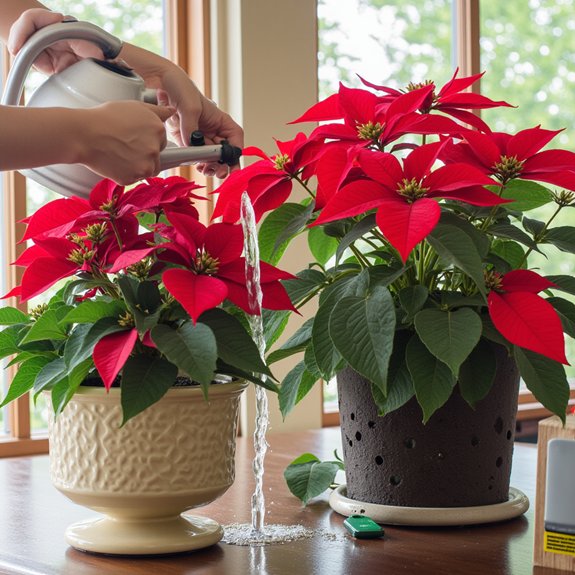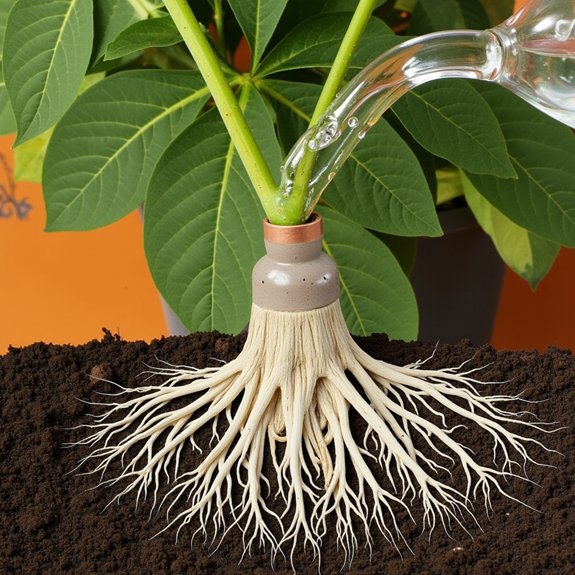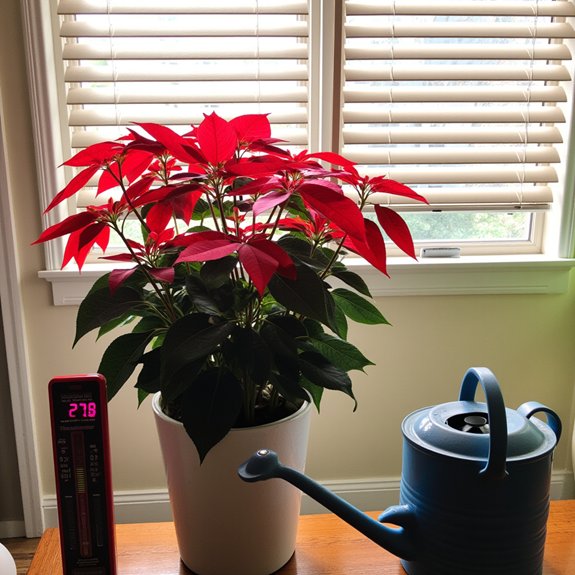You’ll kill more poinsettias with watering mistakes than any other care blunder, but here’s the thing—these vibrant beauties aren’t as fussy as you think. The secret lies in understanding their Mexican mountain origins, where they experience distinct wet and dry cycles. Most people either drown their plants or leave them parched, missing the sweet spot that keeps those colorful bracts glowing. Master this balance, and you’ll discover why some poinsettias thrive while others become December casualties.
Contents
- 1 Understanding Poinsettia Watering Frequency and Amounts
- 2 Native Habitat Insights for Optimal Moisture Management
- 3 Proper Watering Techniques for Healthy Root Systems
- 4 Identifying and Addressing Overwatering and Underwatering Symptoms
- 5 Environmental Factors That Impact Your Poinsettia’s Water Needs
Understanding Poinsettia Watering Frequency and Amounts

One simple rule governs poinsettia watering: aim for once weekly, but don’t become a slave to the calendar. Your poinsettia soil holds the real answers. Check moisture levels by pressing your knuckle into the top inch—dry means it’s watering time.
Pour 12 fluid ounces for 6-inch pots, 20 fluid ounces for 8-inch containers. These amounts guarantee proper saturation without drowning roots. Your plant’s moisture retention depends on room temperature, humidity, and light exposure.
Skip rigid schedules. Instead, observe your plant’s actual needs. Hot, dry rooms accelerate water loss, while cooler spaces slow consumption.
Native Habitat Insights for Optimal Moisture Management
Deep within Central America’s tropical forests, poinsettias developed their watering preferences over centuries. These tropical origins explain why your plant craves consistent moisture without waterlogged conditions. In their native habitat, poinsettias experience abundant rainfall followed by seasonal dry periods, creating perfect moisture retention patterns.
You’ll notice your poinsettia thrives when you mimic these natural cycles. The forest floor stays consistently moist but never soggy, thanks to excellent drainage and high humidity levels. Understanding this balance helps you avoid common watering mistakes that kill these beautiful plants during winter months.
Proper Watering Techniques for Healthy Root Systems

When you water your poinsettia correctly, you’re creating the foundation for a robust root system that’ll keep your plant thriving all season long. Start by watering until soil becomes fully saturated, allowing excess water to drain completely through the holes. This guarantees peak root health without waterlogging.
Rotate your pot during watering for even moisture retention throughout the soil. If water runs straight through without absorbing, your soil’s likely compacted. Switch to bottom watering, letting roots draw moisture upward naturally.
Clear drainage holes regularly to prevent standing water, which damages roots quickly and compromises your plant’s overall health.
Identifying and Addressing Overwatering and Underwatering Symptoms
Recovery methods depend on the problem. For overwatering, let soil dry completely before watering again, consider repotting if roots are damaged. Underwatered plants bounce back within hours using bottom watering if roots remain healthy.
Environmental Factors That Impact Your Poinsettia’s Water Needs

Your home environment plays a bigger role in your poinsettia’s watering needs than you might realize. Light exposure directly affects how quickly soil dries out—plants near sunny windows need water more frequently than those in dimmer spots. Hot air from heating vents accelerates moisture loss, while cold drafts from windows stress your plant and alter its hydration patterns.
Humidity levels matter too, since poinsettias naturally thrive in Central America’s moist tropical forests. Dry indoor air forces them to work harder, increasing their water demands. Monitor these conditions closely, adjusting your watering schedule based on your specific environment rather than following rigid timing.
